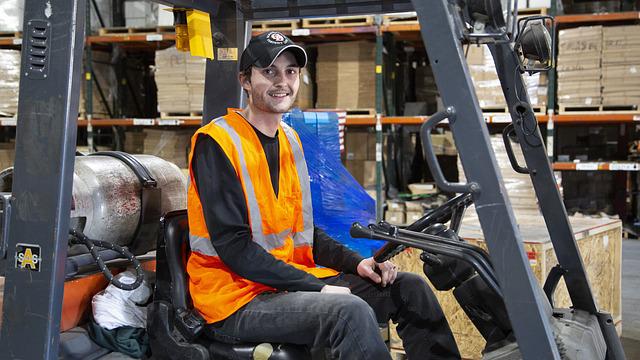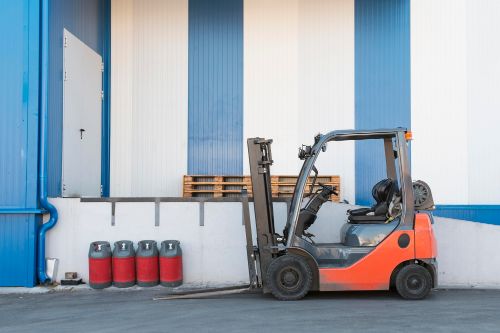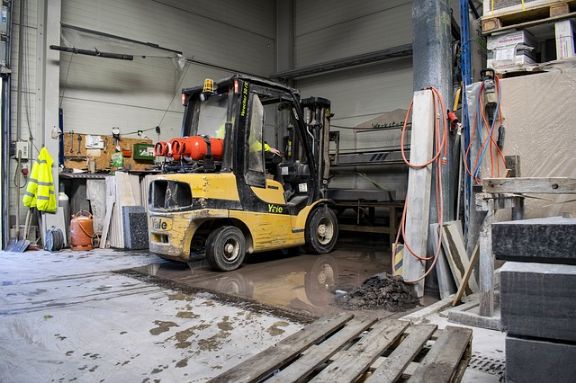
If you’re in the market for a new forklift propane cylinder, there are a few things you should know. First, propane is a clean-burning, affordable fuel that is available in a variety of sizes. Second, forklift propane cylinders for sale come in both new and used options. And finally, when shopping for a propane cylinder, be sure to consider the weight capacity, warranty, and price.
Forklift propane cylinders are available in a variety of sizes and styles to suit your needs. They are ideal for use in forklifts and other equipment that require a reliable source of propane.
Most cylinders are made from high-strength aluminum and are designed to withstand the rigors of daily use. They feature a corrosion-resistant finish and are equipped with a pressure relief valve for safety. There are also steel cylinders that are prone to rust and corrosion. The choice between aluminum and steel is up to your decision on which one to buy.
Forklift propane cylinders can be found at most hardware stores and online retailers. Be sure to select the proper size and style for your equipment.
How to Choose Forklift Propane Cylinders
When choosing forklift propane cylinders, there are several factors to consider to ensure that you select the right cylinders for your needs. Some important considerations include:
- Compatibility: It is important to choose propane cylinders that are compatible with your forklift. This means that the cylinders must have the right size, shape, and connection type to fit securely onto your forklift and provide the necessary fuel supply.
- Capacity: The capacity of a propane cylinder refers to the amount of fuel that it can hold. It is important to choose cylinders with the right capacity to meet your forklift’s fuel needs. Larger cylinders will provide a longer-lasting supply of fuel, but they may also be heavier and more difficult to handle.
- Safety: Propane is a flammable fuel, so it is important to choose cylinders that are designed and certified to meet safety standards. Look for cylinders with labels or markings indicating that they meet the safety standards set by the U.S. Department of Transportation (DOT) and other relevant agencies.
- Quality: It is important to choose high-quality propane cylinders to ensure that they are durable and reliable. Look for cylinders that are made from high-quality materials and have a reputation for durability and reliability.
- Price: The price of propane cylinders can vary depending on their size, capacity, and other factors. It is important to compare prices from different suppliers to ensure that you are getting the best value for your money.
Understanding the specific requirements of your forklifts is critical in selecting the appropriate propane cylinders. Here’s a breakdown of what to consider:
A. Determining the Size and Power Needs of Your Forklift:
- Engine Size: The size of the forklift’s engine will influence the rate of propane consumption and the required cylinder size.
- Operational Load: Larger, more powerful forklifts that carry heavier loads will require more fuel, thus larger or more cylinders.
- Space Constraints: Consider the physical space on the forklift for mounting the cylinder. There must be adequate room for installation and proper ventilation.
B. Compatibility with Different Cylinder Types:
- Connection Types: Ensure that the cylinder’s valve type matches the forklift. Incompatibilities here can lead to leaks or fitting issues.
- Mounting Requirements: The cylinder must fit the designated mounting brackets or space on the forklift. Adapters are available but it’s best to have a direct fit.
- Orientation: Some forklifts require cylinders to be mounted vertically or horizontally, and using the wrong orientation can affect performance and safety.
C. Importance of Considering the Lift Capacity of the Forklift:
- Operational Efficiency: A forklift with higher lift capacity may require more power and hence a larger or more efficient fuel supply.
- Safety Considerations: Overloading the forklift or using an undersized cylinder can lead to safety issues or reduce the forklift’s operational life.
- Matching Cylinder to Usage: Selecting the cylinder capacity that corresponds to your lift capacity ensures that you are not paying for excess propane or falling short during critical operations.
D. Fuel Consumption Rates and Operational Hours:
- Average Consumption: Understanding how much fuel your forklift consumes on average will help in selecting the right cylinder size for optimal refueling intervals.
- Peak Operating Times: Consider if your forklift operates continuously during peak times, which may require a more efficient fueling system to minimize downtime.
- Shift Patterns: If your forklift operates over multiple shifts, you may need a larger cylinder or a plan for refueling that doesn’t interrupt operations.
- Backup Cylinders: Depending on your operational hours, having spare cylinders on-site can prevent work stoppages.
By carefully evaluating these aspects, you can choose a propane cylinder that matches your forklift’s power requirements, is compatible with your equipment, and supports your operational workload efficiently. Always refer to the manufacturer’s specifications and consult with a fuel specialist if needed to ensure you’re making the most informed decision.
In general, it is best to consult a qualified technician or propane supplier for assistance when choosing forklift propane cylinders. They can help you select the right cylinders for your needs and ensure that they are installed and used safely and properly.
Forklift Propane Cylinder Sizes
Forklift propane cylinders come in a variety of sizes and specifications to suit different needs. The most common size is the 20-pound cylinder, which is typically used on smaller forklifts. Larger cylinders, such as the 33-pound and 100-pound cylinders, are used on larger forklifts. The 33-pound cylinder is the most popular size for industrial use, while the 100-pound cylinder is typically used for agricultural or construction applications.
It is also important to consider the size of the forklift when choosing a propane cylinder. The larger the forklift, the larger the cylinder you will need. A 20-pound cylinder will typically suffice for a small forklift, while a 33-pound or 100-pound cylinder will be required for a large forklift.
| Cylinder Size | Typical Use Case |
|---|---|
| 20 lb | Light-duty applications, small forklifts |
| 33 lb | Medium-duty applications, standard forklifts |
| 43 lb | Heavy-duty applications, large forklifts |
| 60 lb | Industrial applications, extended use forklifts |
| 100 lb | Large industrial applications, multiple shift usage |
DOT vs. ASME Tanks:
- DOT Cylinders: These cylinders are approved by the Department of Transportation for the transport of propane. They are designed to be more portable and are required to be re-certified periodically (typically every 5, 7, or 12 years, depending on the cylinder type and use).
- ASME Tanks: These are approved by the American Society of Mechanical Engineers and are usually designed for stationary use. They do not require re-certification after installation, making them a common choice for fixed systems or permanent installations.
Valves and Fittings Variations:
- Propane cylinders come with different types of valves and fittings, which can include service valves, fill valves, and relief valves. The type of valve needed can depend on the forklift model and the cylinder’s design. It’s important to ensure compatibility between the cylinder’s valves and the forklift’s fueling system for safe and efficient operation.
Steel vs aluminum forklift propane tank
Forklift propane tanks are typically made from either steel or aluminum. Both materials have their own advantages and disadvantages, and the right choice will depend on your specific needs and preferences.
Steel propane tanks are generally more durable and long-lasting than aluminum tanks. They are also more resistant to damage from impacts and other forces. However, steel tanks are typically heavier than aluminum tanks, which can make them more difficult to handle and transport.
Aluminum propane tanks are generally lighter and more portable than steel tanks. They are also more resistant to corrosion and rust. However, aluminum tanks are generally not as durable as steel tanks, and they may be more susceptible to damage from impacts and other forces.
When choosing between steel and aluminum forklift propane tanks, it is important to consider factors such as the weight and portability of the tanks, their durability and resistance to damage, and their overall cost. It is also important to consider the specific needs and requirements of your forklift and the intended use of the propane tanks.
In general, it is best to consult a qualified technician or propane supplier for assistance when choosing forklift propane tanks. They can help you select the right tanks for your needs and ensure that they are installed and used safely and properly.
| Feature | Steel Propane Tanks | Aluminum Propane Tanks |
|---|---|---|
| Weight | Heavier, which may affect forklift handling | Lighter, easier to handle and reduces load on the forklift |
| Durability | Prone to rust, requires more maintenance | Resists corrosion better, generally has a longer lifespan |
| Cost | Generally less expensive upfront | More expensive initially but may have lower lifecycle costs |
| Safety | Can be more robust against punctures | Less prone to sparking, reducing fire risk during handling |
| Maintenance | Requires regular inspection for rust and damage | Requires less maintenance due to corrosion resistance |
| Conductivity | Low thermal conductivity, slower heat transfer | Higher thermal conductivity, faster heat transfer |
| Aesthetic & Cleanliness | May corrode, leading to staining | Maintains appearance better, less likely to stain |
| Environmental Considerations | Potential for higher environmental impact during production and end-of-life disposal | More environmentally friendly production and easier to recycle at end-of-life |
| Recyclability | Recyclable, but less so than aluminum | Highly recyclable, better scrap value |
| Temperature Performance | Performance can degrade in high humidity and salty environments | Better performance in varied environmental conditions |
| Usage in Various Environments | Suitable for indoor and less demanding outdoor environments | Often preferred for harsh outdoor environments |
| Lifecycle | Can be shorter due to corrosion unless properly maintained | Typically longer due to corrosion resistance and structural integrity |
Is the tank you need vapor or liquid withdrawal
The type of propane tank you need for your forklift depends on the type of withdrawal system your forklift has. If your forklift has a vapor withdrawal system, you will need a vapor propane tank. If your forklift has a liquid withdrawal system, you will need a liquid propane tank.
Vapor withdrawal propane cylinders are designed to deliver propane in its gaseous form. This means that the propane is released from the cylinder as a gas and is then transported to the forklift’s engine through a series of pipes and valves. Vapor withdrawal systems are typically used in small and medium-sized forklifts, as they are easy to install and maintain.
Liquid withdrawal propane cylinders are designed to deliver propane in its liquid form. This means that the propane is released from the cylinder as a liquid and is then converted to a gas by a vaporizer before it is transported to the forklift’s engine. Liquid withdrawal systems are typically used in larger forklifts, as they can deliver a more consistent and reliable supply of propane.
When choosing between vapor and liquid withdrawal propane cylinders for your forklift, it is important to consider factors such as the size and type of your forklift, the intended use of the propane, and the availability of propane refill services in your area. It is also important to consider the cost, maintenance, and safety of the different withdrawal systems.
In general, it is best to consult a qualified technician or propane supplier for assistance when choosing forklift propane cylinders. They can help you select the right cylinders for your needs and ensure that they are installed and used safely and properly.
Is the cylinder you need a fill valve or a no-fill valve?
When choosing a forklift propane tank, one of the important factors to consider is whether the tank has a fill valve or not. A fill valve is a valve that is used to fill the propane tank with fuel. It is typically located on the top or side of the tank, and it allows propane to be added to the tank when it is running low.
Forklift propane tanks are available with or without fill valves. Whether you need a tank with a fill valve or not will depend on your specific needs and preferences.
Tanks with fill valves are generally more convenient and easier to use than tanks without fill valves. They allow you to refill the tank with propane when needed, without having to remove the tank from the forklift. This can save time and effort, and it can also help to ensure that the forklift always has a consistent and reliable supply of propane.
Tanks without fill valves are generally less expensive and more portable than tanks with fill valves. They are also easier to store and transport, as they do not have any protruding parts. However, they require the tank to be removed from the forklift in order to refill it, which can be inconvenient and time-consuming.
When choosing a forklift propane tank, it is important to consider whether you need a tank with a fill valve or not. If you need a tank that is easy to refill and maintain, a tank with a fill valve may be the best option. If you prefer a tank that is more portable and less expensive, a tank without a fill valve may be a better choice. It is also important to consult a qualified technician or propane supplier for assistance when selecting a forklift propane tank.
Check whether the propane tank is universal mount or not
To check whether a propane tank is a universal mount or not, you will need to look at the design and mounting mechanism of the tank. A universal mount propane tank is a tank that can be easily mounted on a variety of different devices and vehicles. It is typically designed with a standard mounting bracket or system that allows it to be attached to different types of vehicles and equipment.
To determine whether a propane tank is a universal mount or not, follow these steps:
- Examine the tank to determine its size, shape, and design.
- Look for a mounting bracket or system on the tank. Universal-mount propane tanks typically have a standard mounting bracket or system that allows them to be easily attached to different types of vehicles and equipment.
- Check the instructions or documentation that came with the tank. If the tank is a universal mount, it should be mentioned in the instructions or documentation.
- Consult the manufacturer or a qualified technician for assistance. They can provide information about the mounting capabilities of the tank and help you determine whether it is a universal mount or not.
In general, a propane tank is considered a universal mount if it has a standard mounting bracket or system that allows it to be easily attached to different types of vehicles and equipment. This makes it versatile and convenient to use, as it can be easily moved from one vehicle or device to another. If you are unsure whether a propane tank is a universal mount or not, it is best to consult the manufacturer or a qualified technician for assistance.
The Cost of Purchasing Forklift Cylinders
Forklift propane cylinder prices can vary depending on the size and type of cylinder that you need. The most common type of cylinder is the 20 lb. cylinder, which typically costs between $150 and $200. If you need a larger cylinder, such as a 33 lb. or a 50 lb. cylinder, you can expect to pay between $300 and $350.
Some brands have a reputation for being durable and long-lasting. Other popular brands are known for being lightweight and easy to maneuver. The other consideration that affects the cost is whether the tank is cylinder or steel.
When choosing a brand, it is important to consider the specific needs of your business. For example, if you frequently move heavy loads, you will need a brand that is designed for that purpose. If you have limited storage space, you will need a brand that offers compact cylinders.
It is also important to consider the ease of use. Some forklift brands and models use vertical cylinders while others are in vertical positions.
Finally, it is important to consider the customer service and support offered by the manufacturer. Some companies offer comprehensive customer service and support. Others aren’t that good when it comes to customer support.
5 Gallon, 7 Gallon or 10 Gallon capacity forklift cylinder: the popular size of tanks
When choosing a forklift propane cylinder, one of the important factors to consider is the capacity of the cylinder. Propane cylinders are available in a range of capacities, from small, portable cylinders with a capacity of 5 gallons or less, to larger, stationary cylinders with a capacity of 10 gallons or more.
The capacity of a propane cylinder refers to the amount of fuel that it can hold. The right capacity for your needs will depend on factors such as the size and type of your forklift, the intended use of the propane, and the availability of propane refill services in your area.
If you are unsure about which capacity cylinder to choose, here are some general guidelines to consider:
- 5-gallon capacity: A 5-gallon propane cylinder is a small, portable cylinder that is suitable for use in small and medium-sized forklifts. It is a good choice if you need a cylinder that is easy to handle and transport, and if you are able to refill the cylinder regularly.
- 7-gallon capacity: A 7-gallon propane cylinder is a medium-sized cylinder that is suitable for use in medium and large-sized forklifts. It provides a longer-lasting supply of propane than a 5-gallon cylinder, but it may also be heavier and more difficult to handle.
- 10-gallon capacity: A 10-gallon propane cylinder is a large, stationary cylinder that is suitable for use in large forklifts. It provides the longest-lasting supply of propane, but it is also the heaviest and most difficult to handle and transport.
Selecting the Right Supplier
When selecting a supplier for forklift propane cylinders, there are several key factors to consider to ensure you get the best value, reliability, and service. Below is a detailed discussion of these considerations:
A. Criteria for Selecting a Propane Cylinder Supplier:
- Certifications and Compliance: Verify that the supplier’s cylinders meet national safety standards and certifications. This ensures that the cylinders are safe for use and comply with regulatory requirements.
- Quality of Cylinders: Assess the durability and construction quality of the cylinders. High-quality cylinders can mean fewer leaks and less maintenance.
- Supply Capacity: Ensure the supplier can meet your demand without delay. The ability to provide a consistent supply is crucial for uninterrupted operations.
- Market Reputation: Consider the supplier’s reputation in the market. A supplier with positive reviews and testimonials is likely to be more reliable.
- Price: While not the only factor, competitive pricing is important. However, the lowest price is not always the best option if it compromises quality or reliability.
- Value-Added Services: Look for suppliers offering additional services such as flexible payment terms, cylinder maintenance, and safety training.
Benefits of Choosing a Reputable and Experienced Supplier:
- Reliability: A well-established supplier is likely to be more reliable and deliver on time, helping you avoid any operational downtimes.
- Product Quality: Reputable suppliers often provide higher-quality cylinders that are maintained and tested regularly, ensuring safety and longevity.
- Expertise: Experienced suppliers can offer valuable insights and recommendations tailored to your specific needs.
- Risk Mitigation: A supplier with a strong track record will have established safety protocols, reducing the risk of accidents and liability.
Availability of Customer Support and Services:
- Customer Service: Choose a supplier that offers strong customer support, willing to address issues promptly and effectively.
- After-Sale Services: Look for suppliers that provide after-sale services such as equipment servicing, repairs, and safety checks, which can be crucial for maintaining operational efficiency.
- Emergency Services: In case of emergencies, a supplier with a robust emergency response can be invaluable in minimizing downtime.
Considering the Proximity of the Supplier for Refills and Exchanges:
- Convenience: A supplier nearby can mean faster delivery times for new cylinders and quicker exchanges or refills for empties.
- Cost Savings: Closer proximity can result in lower transportation costs, both for deliveries to you and for returning cylinders to the supplier.
- Environmental Impact: Shorter delivery routes mean a smaller carbon footprint and a more environmentally friendly operation.
- Local Support: Using local suppliers can benefit the local economy and can often mean more personalized service.
Selecting the right propane cylinder supplier involves looking beyond the cost to the overall value they provide, including the quality of their cylinders, their reliability, customer service, and proximity. A reputable and experienced supplier can contribute significantly to the smooth operation of your forklifts and the safety of your operations.
Best Practices for Testing and Replacing Propane Cylinders
When managing propane cylinders for forklifts, safety and efficiency are paramount. Here are the best practices for testing and replacing propane cylinders:
A. Frequency of Cylinder Testing and Inspection
- Regular Inspections: Conduct visual inspections for signs of damage, corrosion, or wear before each use.
- Scheduled Testing: Follow the manufacturer’s guidelines and local regulations for pressure testing and cylinder inspection frequency. Typically, DOT cylinders require testing every 5 to 12 years, depending on the type of service.
- Pre-Refill Checks: Inspect cylinders for damage or leaks every time before refilling.
B. Identifying Signs of Wear and Tear or Damage
- Visual Cues: Look for dents, rust, pitting, or corrosion on the cylinder body.
- Leaks: Use soapy water to check for leaks, especially around valves and seams.
- Operational Issues: Pay attention to unexpected changes in forklift performance, which may indicate issues with the propane cylinder.
- Valve Integrity: Ensure that valves are not sticking, are easy to operate, and do not leak when closed.
C. The Process of Cylinder Recertification
- Certified Professionals: Have cylinders recertified by professionals authorized by the DOT or relevant body.
- Hydrostatic Testing: This involves filling the cylinder with water and pressurizing it to a specific level to check for leaks and strength.
- Visual Inspections: Along with hydrostatic testing, a thorough visual inspection should be performed by the professional.
- Documentation: Keep records of all inspections and recertifications as per regulatory requirements.
D. When to Replace Your Propane Cylinder
- End of Life Cycle: Replace cylinders that have reached the end of their DOT or ASME certification life cycle and cannot be recertified.
- Irreparable Damage: If a cylinder shows signs of serious damage or fails hydrostatic testing, it should be replaced.
- Changes in Regulations: New safety standards or regulations may require upgrades to newer cylinder models.
- Upgrading Fleet: When upgrading your forklift fleet, it may be beneficial to also upgrade to newer cylinders that are more efficient or better suited to the new equipment.
By adhering to these best practices, you ensure that your propane cylinders are safe, compliant, and as efficient as possible, thereby reducing the risk of downtime and accidents.
To Make a Conclusion
Forklift propane cylinders come in a variety of sizes and shapes, so finding the perfect one for your needs can be a challenge. But with a little research, you can find the perfect cylinder for your needs.
When it comes to forklift propane cylinders, there are two main types: vertical and horizontal. Vertical cylinders are the most common type and are typically used for smaller applications. Horizontal cylinders are larger and are typically used for bigger applications.
When it comes to choosing the right cylinder for your needs, it is important to consider the size, type of valve, and application. With a little research, you can find the perfect cylinder for your needs.

Mike is an experienced propane technician with over 15 years of professional experience in the field. He has dedicated his career to helping customers with their propane needs, from installation to maintenance and repair. Together with Jeremy, he co-founded this website to provide useful information and guidance to customers seeking reliable propane services.



